Fanning ISLAND

When we arrived at Fanning, we were planning to stay for about two weeks. We stayed for almost two months! Obviously we enjoyed ourselves at this beautiful island.
Fanning is a part of the Republic of Kiribati. Kiribati is a group of 33 islands spread out over more than one million square miles of the Pacific Ocean. Kiribati includes the 16 Gilbert Islands, the eight Phoenix Islands, Banaba, and eight of the eleven Line Islands. Fanning is one of the Line Islands.
Fanning Island was named after Edmund Fanning, the American explorer that discovered the island in 1798. Its name was officially changed to Tabuaeran when Kiribati became an independent republic in 1979; however, it continues to be called Fanning – even by the local population – so Fanning Island it is.
Fanning is a low-lying atoll less than 4 degrees north of the equator just west of the 159 W meridian of longitude. It measures about 8 miles in a NW-SE direction and 3 to 5 miles in an E-W direction. It has typical equatorial weather – hot, humid, squalls. We were there over seven weeks, and we had only one 24-hour period with no rain. We also saw winds as high as 41 mph inside the lagoon. This is not a place for wimps.
The people of Fanning are Micronesian. Their language is I-Kiribati, and limited English is spoken by only a small portion of the population.
There is a marked lack of infrastructure on Fanning. The residents have no electricity, running water, roads, etc. They live a subsistence lifestyle. Most of the dwellings have thatch roofs over a raised platform without walls, and they are made from coconut fronds. Very little grows there, so their diet consists primarily of fish, rice, and coconut. Although fish and coconut are available locally, the rice is imported on a supply ship that shows up irregularly every few months. There are also numerous pigs – most of which run free. Water is obtained either by catchment or from shallow wells. The well water must be boiled before drinking, but it is in adequate supply.
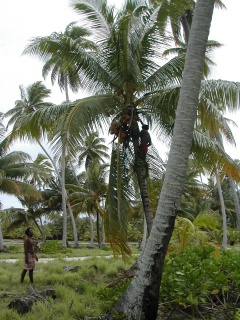
Cutting us some drinking coconuts
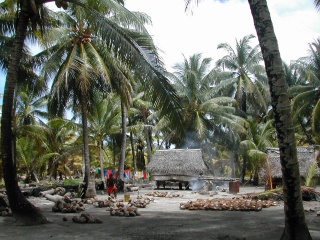
He is splitting copra. She is smoking fish.
There are about eight small villages on island – three north of the pass and five south. The villages are just clusters of dwellings. There are also schools on island from primary through high school – which is a boarding school – but not all children attend school past primary school.
Women care for the children and the home. Most men fish and/or do copra. Copra is heavily subsidized by the government, and the island’s only exports are copra and seaweed.
We were befriended by a local family, and they helped us learn a bit about life on Fanning. This family farms seaweed – the food thickener “agar agar” – and we learned a bit about that. We spent a memorable day at their seaweed farm.
While at their seaweed farm, we met their nearest neighbor, Yotaba, and learned a bit about the sailing canoes we had been admiring. Many of the men fish daily from their sailing canoes which are very narrow outriggers with one small sail. We were particularly surprised to learn that they are small slats of wood lashed together. They are not nailed, screwed, or glued – simply lashed. The sails were made from whatever was available – rice bags, plastic tarps, and a rare piece of old sailcloth. And it was beautiful to see these sail. They appear to be quite stable, and they are fast.
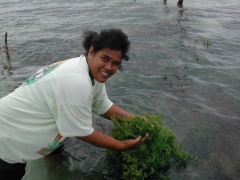
Milliam with seaweed
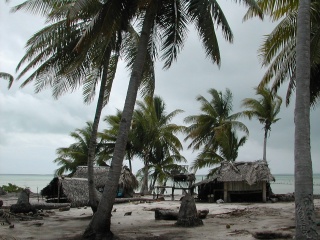
Seaweed farm buildings
Of course we did a bit of diving, and the diving was excellent. We took our dinghy just outside the pass – either north or south – and were continually amazed at all we saw. Flame angel fish are a rare find in Hawaii, and there it was not unusual to see a dozen of them together. We saw rays (manta and spotted eagle), sharks (white tip reef and black tip), and many fish that we could not identify despite our small library on board. The corals were spectacular. After talking to the only diver on the island, we believe that we are only the third and fourth persons to dive our favorite site there. It was pristine virgin coral. Beautiful.
A fun snorkel we did a few times was just riding the incoming tide through the pass. It often runs at four knots, so it was quite a drift. We motored out the pass in the dinghy, jumped in the water, then held on to lines attached to the dinghy as we drifted in as one unit. Very cool.
And then there is the cruise ship… Norwegian Cruise Lines brings a ship – the Norwegian Wind – there two or three times a month for a five hour stay. Why would a cruise ship travel for two days from Hawaii to get to Fanning only to spend five hours ashore then travel two days back to Hawaii? U.S. legislation.
All but a few cruise ships are of foreign registry. Because they are not U.S. registered, they do not have to pay U.S. wages or meet OSHA guidelines. However, they are subject to other federal legislation commonly known as the Jones act. In short, the Jones act requires a foreign-flagged vessel carrying cruise passengers in to and out of U.S. ports to have a foreign port on its itinerary. Hawaii is a long distance from any foreign ports, and Fanning Island is the closest at just over one thousand miles. So NCL came to Fanning, leased an old copra plantation, and staffed it with three men to keep it up. The NCL compound has generators, reverse-osmosis water makers, and even a satellite phone for communications with their corporate office in Florida. They employ 15 islanders on a full time basis, and they employ 30 on ship days.
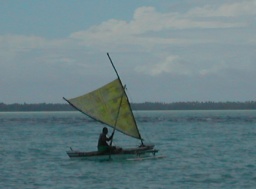
Sailing canoe

There are conflicting opinions on whether NCL is a good or bad thing for the island. Those believing it is a good thing believe that it provides a little cash income to those employed, and those wages improve the lives of the employees. Those believing it is a bad thing believe that it is creating dependence on an outside source that will likely disappear in another two years. Whether good or bad, the island population has grown from 350 to 2,000 in the few years that NCL has been going there.
The increased population is taking a toll on the island and lagoon. The island is littered with trash and beer cans, and the lagoon is the trash site and toilet for the residents. Possibly the environment could absorb this with only 350 residents, but it cannot absorb it from 2,000. Their beautiful island and lagoon is being trashed. Kiribati has not protected the environment of any of their other islands, so it is not likely that they will protect Fanning. That is unfortunate because, so far, Fanning is still a beautiful island.
Read about our sail south across the equator or jump ahead to the Cook Islands.